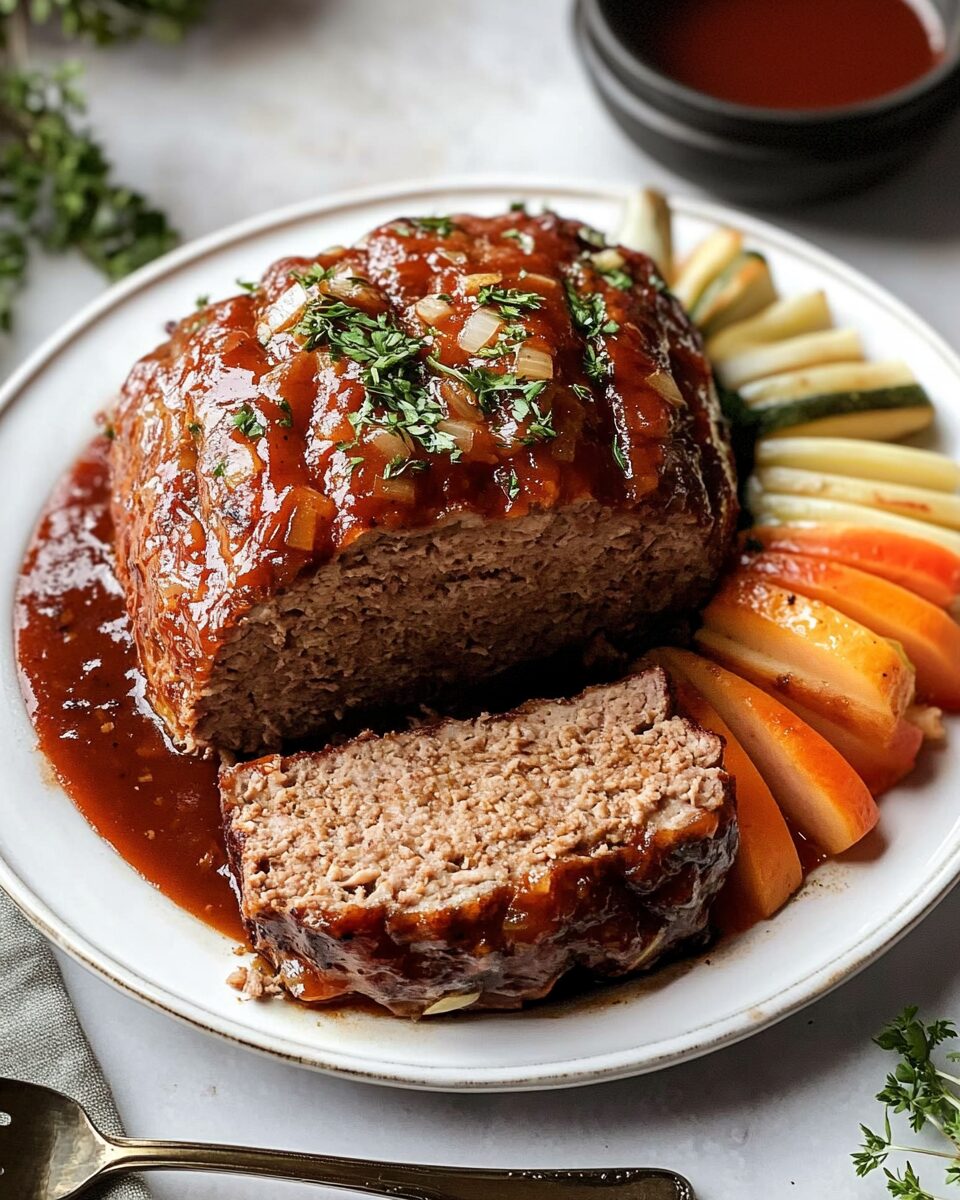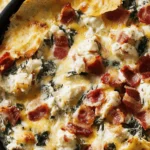The humble meatloaf may not sound fancy, but when made with care, it transforms into a hearty and comforting centerpiece worthy of any dinner table. This classic version sticks to tradition moist and flavorful ground beef, perfectly seasoned and topped with a glossy, tangy glaze that caramelizes beautifully in the oven.
It’s the kind of dish that fills the kitchen with mouthwatering aromas and brings everyone to the table. Whether you’re serving it with mashed potatoes and green beans or slicing it into sandwiches the next day, this meatloaf promises a bite of nostalgia in every forkful.
Full Recipe
Ingredients:
-
1.5 lbs ground beef (80/20)
-
1 large egg
-
1/3 cup milk
-
1 tsp Worcestershire sauce
-
1/2 cup plain breadcrumbs
-
1 tsp Italian seasoning
-
1/2 tsp garlic powder
-
1 tsp salt
-
1/4 tsp freshly cracked black pepper
-
1/2 cup finely minced onion
For the Glaze:
-
1/2 cup ketchup
-
1 Tbsp brown sugar
-
1 Tbsp Worcestershire sauce
-
1 tsp yellow mustard
Directions:
-
Preheat the oven to 350°F (175°C).
-
In a small bowl, whisk together the egg, milk, and Worcestershire sauce.
-
In another small bowl, combine breadcrumbs, Italian seasoning, garlic powder, salt, and pepper.
-
Finely mince the onion.
-
In a large mixing bowl, add the ground beef, egg mixture, breadcrumb mixture, and minced onion. Use your hands to gently mix until evenly combined. Avoid overmixing.
-
Shape the mixture into a loaf approximately 8″ long, 4″ wide, and 2″ tall, and place it on a rimmed baking sheet or dish.
-
Mix the glaze ingredients in a small bowl. Spread the glaze evenly over the top and sides of the meatloaf.
-
Bake for 50-55 minutes or until the internal temperature reaches 165°F (74°C).
-
Let the meatloaf rest for 5-10 minutes before slicing and serving.
Prep Time: 15 minutes | Cooking Time: 55 minutes | Total Time: 1 hour 10 minutes
Kcal: 328 kcal per serving | Servings: 6
The Enduring Charm of Classic Homemade Meatloaf
Classic homemade meatloaf holds a special place in the pantheon of comfort foods. It’s a dish that embodies warmth, simplicity, and heartiness qualities that have made it a beloved staple in kitchens around the world for generations. Whether served at a family dinner, a holiday gathering, or a casual weeknight meal, meatloaf’s enduring popularity comes from its ability to provide both nourishment and nostalgia in every slice.
A Culinary Staple with Deep Roots
The history of meatloaf dates back centuries and spans numerous cultures. Early versions of meatloaf-like dishes appear in ancient Roman texts, where minced meat mixed with spices and fillers was shaped into loaves and cooked. However, the meatloaf most of us know and love today has its roots firmly planted in American cuisine.
During the Great Depression in the 1930s, meatloaf became a practical and economical meal choice for many families. With meat being relatively expensive, it was stretched by combining it with inexpensive fillers such as breadcrumbs, oats, or vegetables. This not only made the meat last longer but also created a filling and flavorful dish that could feed a family on a budget.
Post-World War II, meatloaf’s popularity soared as it became synonymous with wholesome home cooking. Its ability to be prepared in advance, baked in a single dish, and served with an array of sides made it a versatile and beloved dinner option. Over time, it has evolved with countless variations, yet the classic recipe remains a comfort food icon.
The Science of a Great Meatloaf
The perfect meatloaf strikes a delicate balance between flavor, moisture, and texture. One of the challenges home cooks face is avoiding dryness. This is typically managed through the use of binders like eggs and moisture-enhancing ingredients such as milk or broth. These components not only hold the loaf together but also ensure it remains tender and juicy.
The choice of meat plays a crucial role. Ground beef with a moderate fat content—around 15-20% fat—is ideal, as it provides richness and flavor without becoming overly greasy. Some recipes also combine beef with pork or veal for added complexity.
Seasonings are where the meatloaf truly shines. Classic versions often feature onions, garlic, salt, pepper, and herbs, but there is plenty of room for creativity. The finishing glaze commonly a blend of ketchup, brown sugar, and mustard adds a tangy sweetness that caramelizes beautifully during baking, enhancing both taste and appearance.
Tips for Success
If you’re making classic meatloaf at home, a few tips can elevate your dish from good to outstanding:
-
Avoid Overmixing: When combining your ingredients, mix just until everything is combined. Overworking the meat can make the loaf dense and tough.
-
Use Soaked Breadcrumbs: Adding breadcrumbs soaked in milk or broth improves texture by introducing moisture and tenderness.
-
Don’t Skip the Glaze: The topping adds a flavor contrast and an appealing sheen, so be generous with it.
-
Rest Before Slicing: Allowing the meatloaf to rest after baking helps the juices redistribute, making slices cleaner and more flavorful.
-
Check for Doneness: Use a meat thermometer to ensure the internal temperature reaches 160°F (71°C) for safety and optimal texture.
Serving Suggestions
Classic meatloaf pairs wonderfully with a variety of traditional sides that complement its rich flavors. Creamy mashed potatoes are the quintessential companion, offering a smooth and buttery contrast to the savory loaf. Roasted or steamed vegetables like green beans, carrots, or peas add a fresh balance and vibrant color to the plate.
For a homestyle meal, consider serving meatloaf alongside a simple garden salad or coleslaw. During cooler months, hearty sides like baked macaroni and cheese or buttery corn on the cob make for a cozy, satisfying dinner.
Leftover meatloaf is also incredibly versatile. Slices can be repurposed into sandwiches with melted cheese and a spread of mustard or mayo, making for an easy and delicious lunch option.
Variations on a Classic
While the traditional beef meatloaf remains a favorite, numerous variations allow the recipe to fit different tastes and dietary needs:
-
Turkey or Chicken Meatloaf: Leaner meats can be used for a lighter version, often requiring additional moisture to prevent dryness.
-
Vegetarian Meatloaf: Made with lentils, mushrooms, beans, or textured vegetable protein, these versions offer a hearty plant-based alternative.
-
Stuffed Meatloaf: Filling the loaf with cheese, vegetables, or even hard-boiled eggs can add exciting textures and flavors.
-
Spiced or International Flavors: Incorporate ingredients like cumin, smoked paprika, or soy sauce to give meatloaf a global twist.
-
Gluten-Free Adaptations: Using gluten-free breadcrumbs or oats makes this classic accessible for those with gluten sensitivities.
Storage and Meal Prep
One of the practical advantages of meatloaf is its excellent make-ahead potential. You can prepare the mixture a day in advance and bake it when ready, or cook the loaf and refrigerate leftovers for up to four days. Meatloaf also freezes well, either whole or in slices, making it perfect for batch cooking and busy weeknights.
When reheating, covering the meatloaf with foil in the oven helps retain moisture. Alternatively, microwaving slices with a damp paper towel over the top can prevent drying out.
The Emotional Connection
Beyond its ingredients and cooking techniques, meatloaf holds an emotional place in many hearts. It’s a dish tied to family traditions, childhood memories, and moments of care and comfort. In a world of fast food and complex culinary trends, the simple satisfaction of a well-made meatloaf continues to resonate with people seeking warmth and familiarity.
Conclusion:
Classic homemade meatloaf is much more than a humble dinner option. It is a dish steeped in history, practicality, and love. With its rich flavors, comforting textures, and adaptability, meatloaf has earned its place as a timeless favorite in kitchens across the globe.
Whether you’re a seasoned cook or a beginner, mastering this recipe offers the chance to create meals that nourish the body and soul alike. As families gather around the table to share slices of meatloaf, they share more than food they share connection, tradition, and warmth.






